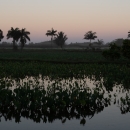This document is 508 Compliant.
The U.S. Fish and Wildlife Service has completed a Wetlands Management and Waterbird Conservation Plan and Environmental Assessment for Hanalei National Wildlife Refuge.
The WMWCP describes the processes and procedures needed to achieve Hanalei NWR’s management objectives, including those related to threatened and endangered (T&E) Hawaiian waterbird conservation, for approximately 480 acres of rotational managed wetland (moist-soil) units, lo‘i kalo (wetland taro [Colocasia esculenta] fields), ditches and dikes, fallow, riparian riparian
Definition of riparian habitat or riparian areas.
Learn more about riparian habitat, and associated uplands. The EA for the WMWCP describes two alternatives: no-action (current management) and action (preferred). The preferred alternative (implementation of the WMWCP) addresses management on the Refuge to: (1) promote and provide habitat for the life stages of the T&E species for which the Refuge was established (Endangered Species Conservation Act of 1969, 16 United States Code [U.S.C] 668aa; Statute 275); (2) reduce loss of T&E species due to predation, competition, or hybridization with non-native species; (3) reduce the loss of T&E species due to disease; and (4) ensure that the Refuge’s farming and grazing programs are compatible with the Refuge’s purpose of recovering T&E species and in compliance with the applicable laws, regulations, and policies of the Service (e.g., Appropriate Refuge Uses, 603 U.S. Fish and Wildlife Service Manual [FW] 1; Compatibility, 603 FW 2; and Cooperative Agricultural Use [CAU], 620 FW 2).




